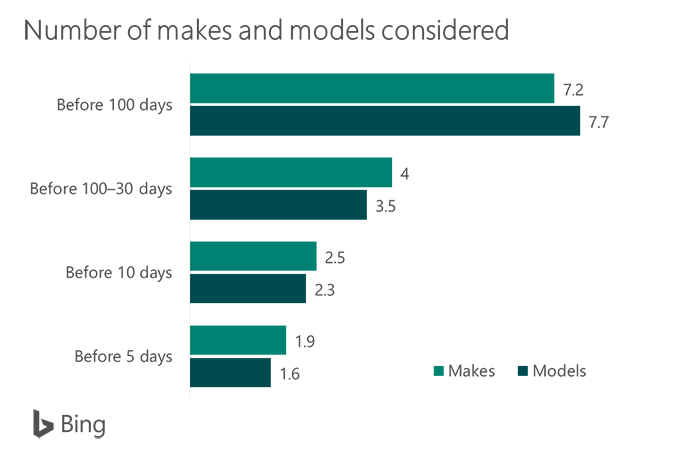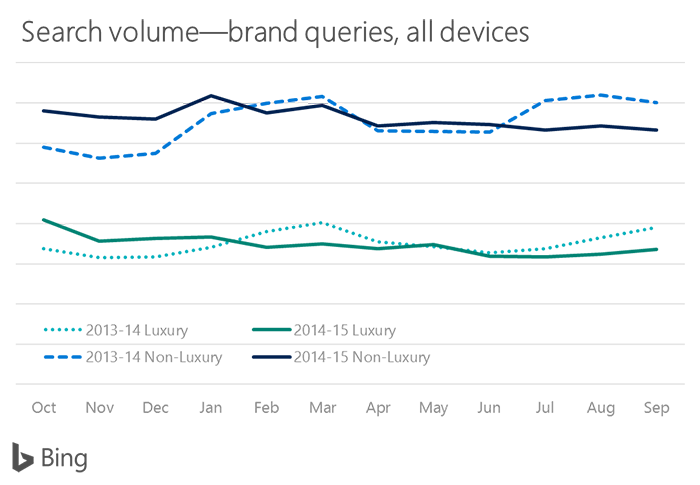With Q1 on the books, it’s the perfect time to look at your numbers and see how you’re fairing in the online marketplace for 2016. Could you do better with your digital spend? Perhaps. Can Bing Ads help you maximize the quality and boost the quantity of car buyers to your site? Yes!
While you’ve been doing what you do best – selling – we on the Bing Ads team have been doing what we do best – monitoring search trends and adding new features (like Image extensions) to our ad platform to help auto manufacturers, dealerships and agencies get more clicks and conversions.
2016 suggests continued growth in the car-buying market. A strong consumer confidence index, low interest rates and a much-needed break in gas prices are all fueling a projected increase in auto sales of $3.4 billion over 2015.[1] How much you grab depends, in part, on how skillfully you spend your online marketing dollars. Luckily, we spent half of last year studying the behavior of online auto shoppers.
Below are six tips to get you on the road to some quick wins. They are designed to help you create, target, implement and measure the most effective ads to lift conversions.
1. Target auto shoppers early in and throughout their journey
We followed 3,000 users on their automotive Consumer Decision Journey (CDJ) and captured the details in Bing Ad’s 2016 Automotive Insights presentation. We found that the average consumer journey lasted 96.3 days, with visits to automotive websites every 4.3 days.[2]
During that time, consumers considered 9.8 makes and 11.4 models on average. When they first start looking for a new vehicle, consumers throw a wide net which narrows as they get closer to purchase. Make sure your makes and models are part of the early consideration set. With 20% of automotive related page views on search engines and with visits to search engines taking place throughout the CDJ, paid search campaigns are a sure fire way to reach car shoppers.

Use Universal Event Tracking (UET) and Remarketing in Paid Search to target shoppers throughout that 3-month journey. Place one UET tag across your website and track what your customers are doing after they click on your ad. When used in conjunction with remarketing lists, you get a second chance with to turn website visitors into customers by showing them tailored ads based on their previous actions.
2. Budget appropriately for your auto campaigns
In looking at search volume over the year, we found fairly steady volume throughout the year with a few spikes over the summer and around the holidays.[3] Make your biggest investment in your year-round, ongoing campaigns, while having some flexibility to adjust to summer travel and winter new model spikes.

To streamline campaign management, set up Automated Rules to schedule and automate your campaign management operations. Use these rules to enable and pause ads, ad groups and campaigns, to adjust keyword and ad group bids, or to change a campaign’s budget automatically based on the criteria you select. You can also use the Notify Me rules to proactively monitor your budgets and performance for a specific timeframe or throughout the year.
3. Focus on your local market
Automotive searchers want to know what dealerships and inventory are available in their local market. Bing Ads found that searches for online marketplaces (such as “cars com” and “craigslist cars”) account for half of automotive related search volume.3 If you’re a dealership, you can take advantage of online marketplace related searches’ high volume and low cost-per-click (CPC) by focusing on keywords for your own dealership and for local pages of popular online marketplaces.

To help drive foot traffic into your local dealership, use Call extensions and Location extensions, which can lift click-through rate (CTR) by up to 10% and 20%, respectively. Call extensions, like click-to-call, help customers quickly call and connect to your business. Location extensions, like store locator and click-to-direction, help customers quickly find your business. And don’t forget to layer in location targeting to ensure optimal customer experience and the most relevant leads.
4. Show off your inventory with image extensions
In our CDJ study, we found that 4 in 10 automotive related searches are for images.2 Furthermore, 45% of consumers viewed more than 36.7 car images on a search engine. Leverage this tendency and add more visual appeal to your ad with Image extensions. Adding images of your latest models to your ad can help grab searchers’ attention and increase clicks.

5. Grow your business, grow yourself
To make the most of your campaigns, take advantage of more offerings from our platform to connect with more customers and get better return on investment. They’ll help you stand out from the competition.
· To direct customers to specific pages on your website, check out Sitelink and Enhanced Sitelink extensions. These extra links let you promote specific products, services or sections of your site, and they lead searchers to the information they need to learn more and take action. They can boost CTR by up to 13% over standard text ads.
· To reach specific demographics, use Demographic targeting. Over the past year, Bing Ads has improved our demographic targeting with increased age and gender coverage to help you improve the chance of your ads showing to the demographic groups you want.
· To free up some time to sell some cars, let our expert Bing Ads coaches help you plan, create and improve your ads. They can help your set up your account, import your ads from current Google AdWords account, and more. They can also help you get familiar with the tools, events and resources that will help you successfully manage your PPC campaigns. Did we mention this is free? No cost, no commitment. Just an easy way to help you get up and running with Bing Ads.
6. Reach quality Bing Network audience
To make the most of your automotive campaigns, get to know the Bing Network audience. Numbers show that about 22 million searchers used the Bing Network – including 17 million unique searchers not reached on Google – for 87 million automotive related searches, and accounted for 41% of all automotive paid clicks[4]. Compared to Google, the Bing Network audience is more likely to have bought a new vehicle offline in the last 6 months, and to plan to buy a convertible/sports car in the next 6 months.[5] For more insights on our audience, visit our Audience Insights page.
Armed with this new knowledge and with Q2 underway, now might be the best time to sign in to Bing Ads and see how your current campaigns are working for your business.
Let Bing Ads help you put your online campaigns into overdrive! Check out more search trends and automotive insights in our infographic below and in our Automotive Insights presentation.
For more seasonal and vertical insights, check out the Bing Ads Insights Portal.
[1] IBISWorld, IBISWorld Industry Report 33611a: Car & Automobile Manufacturing in the U.S., September 2015;
IBISWorld, IBISWorld Industry Report 33611b: SUV & Light Truck Manufacturing in the U.S., January 2015.
[2] Microsoft internal analytics data. Sample: 3,000 users on an Automotive Consumer Decision Journey, with at least 50 page views on automotive related domains. PC traffic only. Timeframe: 1/1/2015 to 6/30/2015.
[3] Microsoft internal query analytics data. Timeframe: 10/1/2014–09/30/2015.
[4] comScore qSearch (custom), US, June 2015; industry categories based on comScore classifications.
[5] comScore Plan Metrix, US, June 2015, custom measure created using comScore indices and duplication. June data was used to reflect the month prior to the beginning of the automotive season.